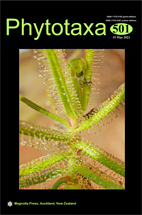Abstract
Angelonia Bonpl. in Humboldt & Bonpland (1809: 92) is the largest genus of the neotropical tribe Angelonieae of the Plantaginaceae, formerly included in the Scrophulariaceae, comprising ca. 30 species, and characterized by the strongly zygomorphic corolla with a saccate tube, internally covered with oil-producing trichomes (Souza & Giulietti 2009, Martins et al. 2014). Angelonia micrantha Bentham (1846: 252) and A. micrantha var. perennis Chodat & Hassler (1904: 285) were recognized in this genus until Barringer (1983) transferred them to the therein described Monopera Barringer (1983: 111), elevating the latter taxon to the specific level. Baringer (1983) argued that Monopera differed from Angelonia by the unisaccate corolla (vs. bisaccate), the absence of a tooth-like appendage in the corolla lower lip (vs. presence), and the reticulate-echinate seeds (vs. reticulate-scalariform).

